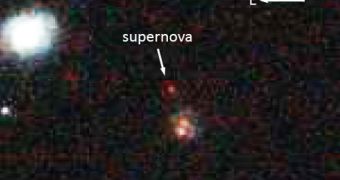While some supernova explosions are just pretty, others are great tools for expanding our understanding of the universe. Scientists using the venerable Hubble space telescope have been able to get a shot of the oldest supernova explosion known that can still provide valuable scientific data.
The explosion is the result of a Type Ia supernova, SCP-0401 to be exact, reaching the end of its live. It happened 10 billion years ago, way before the solar system existed.
But since it happened in a faraway corner of the universe, the light from the event is only now reaching us. Which is great for scientists who happened to be watching just as the supernova exploded.
They've been able to measure the light intensity increase as the star exploded and the subsequent aftermath. It's not just a pretty spectacle, Type Ia supernova explosions are very important in mapping the universe.
Type Ia supernovae result from the explosion of a white dwarf. These small dense stars accrete material from a companion. In time, as their mass increases, the gravity is not enough to keep the accelerated fusion process in check, leading to an explosion.
This explosion creates a very particular light curve, i.e. the intensity and the spectrum of the light follows a very strict path during the explosion and after. All Type Ia supernovae follow this curve enabling scientists to determine things like distance.
There is some debate over whether all Type Ia supernovae behave the same, but if they do, then the light hitting us will be altered only by distance.
The further away it is, the dimmer the light will be, a measure of straight-line distance. The more red shifted it is, the more the universe has expanded during its travels.
SCP-0401 is the furthest such Type Ia supernova that has been observed in enough detail to be able to capture the light curve entirely. A redshift of 1.71 indicates that the star is some 10 billion light years away, at the currently accepted expansion rates.
Studying it should provide data on whether the rate of expansion of the universe has changed since the early days, offering clues into the nature of dark energy.
"This is the most distant supernova anyone has ever found for doing dependable cosmology," David Rubin, a member of the international Supernova Cosmology Project (SCP) based at Berkeley Lab, explained. The results of the study will be published in the Astrophysical Journal and can be found here.
"The most important unanswered question we have about the nature of dark energy is whether it varies over time – whether it affects the expansion of the universe differently in different eras. With SN SCP-0401, we have the first example of a well-measured supernova sufficiently far away to study the expansion history of the universe from almost 10 billion years ago," he added.

 14 DAY TRIAL //
14 DAY TRIAL //